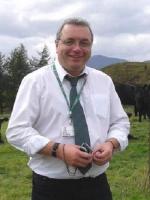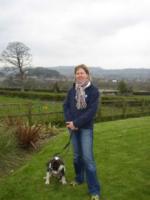
Work Package Agricultural systems and land management
Introduction
Higher yields to meet increasing global demand for food must be balanced by considerations of the wider impacts of farming. Ways must be found to balance farm performance to achieve farm profits while promoting animal health/welfare, the environment, and the future sustainability of production practices. There are three main areas comprising this research: two different sheep systems are under investigation at SRUC's Kirkton & Auchtertyre upland research farms; JHI are assessing key sustainability indicators of arable crop production; and SRUC livestock scientists are investigation the economic and environmental positives and negatives (trade-offs) associated with protein supplementation in mammals and enrichment of laying housing for free-range hens.
Aim of Research
The key aims and drivers of this research are:
Trade-offs in livestock systems. There is a need to understand how best to improve the production, economic and wider environmental resilience and sustainability of upland sheep systems which cover over 60% of farmed land in Scotland. This project has established two alternative Precision Livestock Farming (PLF)-based upland sheep systems and is subsequently comparing and contrasting the overall sustainability of the systems. Sustainability metrics being assessed include a focus on environmental implications (e.g. above and below ground carbon sequestration; use and importation of nutrients and feed from on-and off-farm sources) and animal health and welfare implications (e.g. longevity of livestock; incidence of diseases; lamb survivability), as much as on more traditional productivity and economic metrics;
Trade-offs in arable systems. Intensification of arable production since the early 1970s has tended to maximise commercial off-take but to the detriment of supporting and regulating services. Continuing to maximise inputs and off-take is not sustainable, since supporting services will begin to limit yield, however high the inputs. A more balanced strategy is now needed. This research is using extensive existing data on the performance of crops and their management to explore trade-offs in short-term productivity with longer-term economic and environmental sustainability and to identify the optimal combination of crops and the management of those crops for future arable production.
Trade-offs case studies. Two case studies are assessing trade-offs between costs and benefits of interventions on system efficiencies. The first is exploring in-depth the environmental and economical trade-offs associated with protein supplementation to improve health and performance making use of historic sheep and rodent studies. The second, building on work elsewhere in the Strategic Research Programme on laying hens, is using performance and economic data on housing and feather pecking management for cost-benefit analysis on alternative housing and improved welfare. For both case studies, data is being used to assess whether the interventions (protein supplementation and alternative housing) results in trade-offs or win-win situations.
Progress
Progress in this year is provided for each of the different aspects of this research. Two different sheep systems are under investigation at Kirkton & Auchtertyre while livestock scientists are also investigating the economic and environmental positives and negatives (trade-offs) associated with alternative housing systems for laying hens and protein supplementation in mammals.
Trade-offs in livestock systems. The comparisons conducted between Yrs 1-5 have indicated that while the Lleyn breed does bring performance advantages over the Scottish Blackface, the former does not cope well in bad weather years. In addition, to be sustainable going forward any sheep breed in the hills needs to be able to convert the forage and fodder available efficiently. In general, CO2e output per LU was slightly higher [irrespective of breed] for those sheep in the Hill enterprise, but overall CO2e output was higher for those in the Park enterprise as they were more productive (in terms of livestock numbers). The primary focus in Year 6 was therefore on highlighting the main findings from the research. This was achieved through the use of a variety of media, especially a number of podcasts, webinars and a 30 minute TV programme hosted by the Farm Advisory Service. The results of the research were also highlighted through presentations made at a two-day Scottish Sheep Industry Conference, held online on the afternoons of Tuesday 19th and Wednesday 20th January 2022. This two-day event highlighted wider SRUC and Moredun sheep related findings from the RESAS programme over the past 6 years.
Trade-offs case studies The case studies assessed for trade-offs between costs and benefits of interventions on system efficiencies have clearly demonstrated win-win positions can be achieved. Protein nutrition strategies using case studies in sheep and pigs can be used to improve health, maintain resilient performance and reduce environmental footprint, were presented in a webinar on hillsheep and a face-to-face conference on climate change, respectively. Building on work elsewhere in the SRP on laying hens and using performance, economic data and welfare data on housing and feather pecking management demonstrated cost-benefit analysis of the alternative strategies. The scratch mat study showed only minor changes in behaviour and egg quality, and thus no clear economic benefit was seen. The enrichments for free range hens showed that, while foraging behaviour was not increased with enrichments, peck blocks and alfalfa hay were the most attractive enrichments, but also the most expensive. Both hen studies have been published in open access journal.
Progress in year 5 is provided for each of the different aspects of this research. Two different sheep systems are under investigation at Kirkton & Auchtertyre while livestock scientists are also investigating the economic and environmental positives and negatives (trade-offs) associated with alternative housing systems for laying hens and protein supplementation in mammals. Despite covid restrictions data collection and analyses progressed largely unhindered. However, no face-to-face knowledge exchange events could take place but nevertheless these were replaced by input to a wide range of online workshops, conferences and podcasts.
Highlights
- Trade-offs in livestock systems. Flock performance and productivity metrics were collected throughout the year but covid restrictions did limit the ability to collect other data [e.g. on grass growth] as the limited essential staff on site had to focus on animal welfare priorities. Nevertheless, the collation of the different livestock and environmental datasets collected during years 1-5 was progressed and the findings will form the basis of a workshop and other knowledge exchange events in Year 6. Aspects of the work also formed a focus for podcasts produced by the Farm Advisory Service. Three new H2020 EU funded projects - the focus of which has been developed out of RESAS funded activity at the farms – started during Year 5, though much of the planned activities had to shift to online delivery until March 2021.
- Trade-offs case studies The two hens studies were completed in Y5. With the scratch mat study, the analysis is complete. Data becoming available during Year 5 on strategic amino-acid (AA) supplementation points to reduced protein rations that will assist a reduced reliance on home grown protein sources by allowing for isonitrogenous feed formulation based on digestible AA rather than total protein, which benefits reduced N excretion. AA supplementation to reduced CP rations featured in two publications, and forms the basis of a final program year workshop.
Progress in year 4 is provided for each of the different aspects of this research. Two different sheep systems are under investigation at Kirkton and Auchtertyre upland research farms along with key sustainability indicators of arable crop production. Livestock scientists are also investigating the economic and environmental positives and negatives (trade-offs) associated with alternative housing systems for laying hens and protein supplementation in mammals. Knowledge exchange events through 2019/20 continued to put a focus on hill farming systems and the various steps they could potentially be taking to increase the economic, social and environmental resilience of their systems to climatic and economic shocks.
Highlights
- Trade-offs in livestock systems. Flock performance and productivity metrics were collected from lambing (April 2019), through weaning (September 2019), until the start of Year 5 (pregnancy scanning in February 2020). After poor performance in 2018, the Lleyn ewes recovered much of their form. Good weather following scanning in February 2019 meant that lambing went well for both breeds and was completed late May. That dry weather in April/May 2019 had a knock-on effect by limiting grass growth, but it was still feasible to cut silage in early July and good crop was obtained. Generally good weather continued throughout the remainder of 2019 and - despite some intense periods of heavy rain during the winter – tupping was completed in November/December 2019. The weather conditions in late winter/early spring also meant that the majority of ewes remained in good condition through scanning and the build up to lambing. Carbon footprint analyses have been completed to-date for Year 1 (2015-16), Year 2 (2016-17) and Year 3 (2017-18) of the project. In general, CO2e output per Livestock Unit is slightly higher for the Hill versus Park flock, but overall CO2e output is higher for the Park flock as it continues to be more productive (in terms of overall livestock numbers reared).
- The importance of increasing the economic, environmental and social resilience of fragile upland sheep systems across Scotland has been highlighted in newspaper articles and at a wide range of knowledge exchange events held on and off the farms through the year in association with bodies like Soil Association Scotland, SAC Consulting and the Farm Advisory Service. Other highlights included fact-finding visit to the farms by Mairi Gougeon (Minister for Rural Affairs & Natural Environment) in March 2019 and a Developing Young Workforce (DWY) Rural Skills Day -– aimed at secondary school pupils – held on the farms in May 2019. The latter was organised by SRUC and Perth & Kinross DYW and and featured 10 ‘stands’ with SRUC and external colleagues highlighting different aspects of their work. The Scottish Farmer attended and produced a very favourable write-up of their impressions of the day.
- Trade-offs case studies. Hens - two new studies began, using 9 commercial flocks: trade-offs of extra enrichments (cost, time) in free-range hens to reduce feather pecking (FP) (welfare), and trade-offs of different scratch mat designs (cost) in enriched cages to encourage foraging behaviour and reduce FP (welfare). All scheduled data visits were completed except two (cause: low path AI).
Progress in year 3 is provided for each of the different aspects of this research. Two different sheep systems are under investigation at Kirkton and Auchtertyre upland research farms along with key sustainability indicators of arable crop production. Livestock scientists are investigating the economic and environmental positives and negatives (trade-offs) associated with protein supplementation in mammals. Given impending Brexit, a particular focus was put, through winter 2018/19, on holding workshops to help emphasise to hill farmers what steps they themselves could take to increase the economic viability of their, otherwise very fragile, farming systems.
Trade-offs in livestock systems. Flock performance and productivity metrics were collected from lambing (April 2018), through weaning (September 2018), until the start of Year 4 (pregnancy scanning in February 2019). As anticipated, the adverse winter weather in 2017/18 meant that the Lleyn ewes in the flock had the poorest lambing since the flock was established over 10 years ago. This has highlighted that, while the Lleyns regularly outperform the Blackface ewes, during periods of extreme weather conditions the Lleyns require even more careful monitoring and management. The very dry weather during summer 2018 and subsequent much drier autumn and early winter allowed the Lleyn ewes to regain condition and again scan well in February 2019.
The importance of increasing the sustainability of upland sheep systems has been highlighted in newspaper articles and at a wide range of knowledge exchange events held on and off the farms through the year - in particular, RESAS funding was used to organise three hill-farming focused workshops in Dingwall, Lockerbie and Pitlochry to seek to identify issues that hill farmers themselves would be keen to investigate in more detail e.g. through a Rural Innovation Support Service (RISS) approach. Regular newspaper articles were also used to highlight the relevance of the research being conducted to hill farmers and crofters across Scotland.
Trade-offs in arable systems. A system has been developed that allows the trade-offs between economic and environmental objectives of an arable farming system to be explored. Two objective functions have been developed; the first calculates the gross margin of an arable landscape, and the other, GHG emissions. The system has been parameterised with data from the Centre for Sustainable Cropping experiment. The results show a number of possible crop combinations that meet a set of given constraints.
Multi-objective optimisation software has been developed to explore the trade-offs between economics and the environment in a Scottish arable farming system. The software uses a genetic algorithm to evolve a set of non-dominated crop compositions subject to a set of arable farming constraints. The result of an optimisation using two objective functions is a curve on a 2-D graph with one axis showing "gross margin" and the other "greenhouse gas emissions". The software has been parameterised with data from the Centre for Sustainable Cropping experiment. Preliminary results were presented to the SSCR (Scottish Society for Crop Research) in October 2018.
Trade-offs case studies. Trade-offs of costs versus welfare for laying hens, reported to all BFREPA (British Free Range Egg Producers Association) members (The Ranger, July 2018; trade journal), showed net economic advantages of multi-tier over flat-deck, mainly due to lower feed intake, more eggs per hen housed, and lower mortality. Margin per bird over feed to 70 weeks was £10.32 (flat-deck) vs £10.92 (multi-tier). Environmental footprint of parasitism and by-pass soybean meal was used to assess trade-off between impact on resilience vs environment.
Protein supplementation to parasitized ewes reduced their net footprint per kg lamb weight gain (the functional unit) by 11%, largely due to improvement of feed efficiency.
Progress in year 2 is provided for each of the different aspects of this research. Two different sheep systems are under investigation at Kirkton & Auchtertyre upland research farms, key sustainability indicators of arable crop production and livestock scientists are being investigated the economic and environmental positives and negatives (trade-offs) associated with protein supplementation in mammals. A range of knowledge transfer events took place to raise awareness of the current relevance and importance of the research given the fragility of Scottish farming systems post-Brexit.
Trade-offs in livestock systems. Flock performance and productivity metrics were collected from lambing (April 2017) through weaning (September 2017) until the start of year 3 (pregnancy scanning in February 2018). The adverse winter weather meant that the Lleyn ewes in the flock did not scan well compared to the Blackface ewes, despite having out-performed the Blackface ewes in previous years. Initial analyses of the data from year 1 highlighted a need to think more on how best to incorporate some aspects of the data - e.g. grassland conditions scores throughout the year - more appropriately to each system in future analyses. The very wet summer had an adverse impact on data collection on pollinator occurrence. The importance of increasing the sustainability of upland sheep systems has been highlighted in newspaper articles and at a wide range of knowledge exchange events held on and off the farms through the year, e.g. National Sheep Association events (March 2017), National Farmers Union visits to the farms (June and September 2017), Defra (November 2017) and BBC Countryfile (March 2018).
Trade-offs in arable systems. Optimising crop management and Optimising cropping strategies. The crop performance database continues to be improved and the data used in the multi-attribute modelling of cropping systems in Scotland. The crop performance database has been subject to ongoing review throughout 2017-18 to refine the nature and quality of performance indicators held and to supplement the database with new data as appropriate. The Centre for Sustainable Cropping long-term experiment continues to contribute data for a range of crops under conventional and integrated management, while data on legume crops and mixed cropping available from EU funded projects are being assessed. The crop performance database has contributed to the construction and analysis of a multi-attribute decision model comparing the performance of a range of crops under alternative management scenarios.
The bioeconomic modelling enabling a detailed quantitative assessment of trade-offs is also being improved and extended with the objective of identifying the best performing (sustainable) cropping systems at a range of scales. The bioeconomic model of cropping systems constructed in 2016/17 has been tested. Using data from two sources: published literature and the CSC long-term experiment, the model has illustrated the trade-off in GHG emissions and gross-margin. The model predicts the optimal balance between these measures of economic and environmental performance achieved on the basis of the trade-off, plus the composition of crops and their management within a cropping system associated with these optima. Work continues on the inclusion of multiple performance measures (>2), the addition of a more comprehensive set of management actions and constraints, and refining the process sub-models.
Trade-offs case studies. The bioeconomic model of cropping systems constructed in 2016/17 has been tested. Using data from two sources: published literature and the CSC long-term experiment, the model has illustrated the trade-off in GHG emissions and gross-margin. The model predicts the optimal balance between these measures of economic and environmental performance achieved on the basis of the trade-off, plus the composition of crops and their management within a cropping system associated with these optima. Work continues on the inclusion of multiple performance measures (>2), the addition of a more comprehensive set of management actions and constraints, and refining the process sub-models.
Progress in year 1 is detailed below for each of the different aspects of this research. Two different sheep systems are under investigation at SRUC's Kirkton & Auchtertyre upland research farms, JHI are assessing key sustainability indicators of arable crop production and SRUC livestock scientists are investigation the economic and environmental positives and negatives (trade-offs) associated with protein supplementation in mammals.
Trade-offs in livestock systems. Two separate systems have established. Flock performance, productivity and test sustainability metrics have been collected from lambing (April 2016) through weaning (September 2016) until the start of year 2 (pregnancy scanning in February 2017) and collated into a database for detailed analyses once 2-3 years of data are available. A related 2.3.1 study looking at the impact of different anthelmintic drug treatments on lamb production efficiency and GHG emissions has collated date from 2014-16 and will receive analyses of differences in both greenhouse gas emissions and the occurrence of antibodies to the main nematode worm pest in Year 2.
Trade-offs in arable systems. The outputs for 2016-17 for this objective are reported under the two sub-objectives, Optimising crop management and Optimising cropping strategies. A crop database has been constructed which, following the addition of new data, will be used to quantify the performance of crops with respect to a number of key production and environmental indicators as the basis for subsequent analysis of performance trade-offs. A tool to identify crop combinations that optimise crop production or greenhouse gas emissions has also been developed and will be refined to help identify optimal cropping patterns on the basis of trade-off between production and environmental outcomes.
The next steps have been completed in developing a more advanced tool that will identify optimal cropping patterns on the basis of trade-off between production and environmental outcomes such as yield, chemical application, biodiversity, and soil condition. In addition, historical cropping patterns from nearly 100,000 fields in Scotland have been studied and the impact of removing the most intensive crops and crop sequences on national grain output and chemical application rates has been assessed and a scientific paper prepared for publication.
Trade-offs case studies. This desk study aims to explore economic and environmental positives and negatives (trade-offs) associated with protein supplementation. The first step was a data extraction exercise from existing across-species SRUC studies to obtain data that can inform how efficient feed was used for production purposes. Following a critical assessment of study suitability, the combined data from a total of 17 studies with lactating mammals showed that protein supplementation reduced parasitism and improved feed efficiency. This data will be taken forward to assess the marginal response, i.e. how effective was the additional protein intake achieved used to generate additional production response.
Selected Outputs
SRUC held a Farming & Industry Open Day on Kirkton & Auchtertyre uplands farms on 18th August 2016. Further details available online.
The research was discussed with a range of international visitors to SRUC’s Kirkton & Auchtertyre upland farms through summer 2016. Further details available online
The challenges facing hill farming in Scotland were highlighted at a number of meetings through 2016. Further details available online
Houdijk, J.G.M., Tolkamp, B.J., Rooke, J.A. and Hutchings, M.R. (2017). Animal health and greenhouse gas intensity: the paradox of periparturient parasitism. International Journal for Parasitology 47, 633-641. Read online
Morgan-Davies, C., Lambe, N.,Wishart, H., Waterhouse, A., Kenyon, F., McBean, D. & McCracken, D. (2017) Impacts of using a precision livestock system targeted approach in mountain sheep flocks. Livestock Science 208, 67-76. Published online December 2017 Read online
Davy McCracken contribued to a podcast on efficient grassland management for Scotland’s Farm Advisory Service in August 2018. Listen online
Fox, N.J., Smith, L.A., Houdijk, J.G.M., Athanasiadou, S. and Hutchings, M.R. (2018). Ubiquitous parasites drive 33% increase in methane yield from livestock. International Journal for Parasitology 48, 1017-1021. Read online
Vicky Sandilands produced a report, along with ADAS colleagues, on the differences between multi-tier and flat deck systems for hens, published as a supplement in The Ranger poultry magazine, July 2018. Read online
Clare Taylor (2019) Tech advance makes rural careers more exciting. 6th June 2019 Read online
A range of media outputs from the innovative work on SRUC’s hill farms can be access via the SRUC Rural Brexit Hub – Read online
FAS TV 2021. Kirkton Farm Special: Electronic ID, Feed Efficiency and Biodiversity. Farm Advisory Service TV, Episode 8 View Online
Sandilands, V.; Baker, L.; Donbavand, J.; Brocklehurst, S. Effects of Different Scratch Mat Designs on Hen Behaviour and Eggs Laid in Enriched Cages. Animals 2021, 11, 1544. Read online
Sandilands, V.; Baker, L.; Donbavand, J.; Brocklehurst, S. Do Hens Use Enrichments Provided in Free-Range Systems? Animals 2022, 12, 995. Read online





